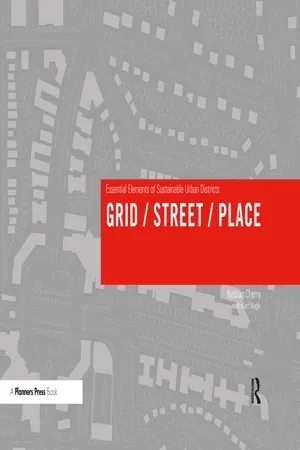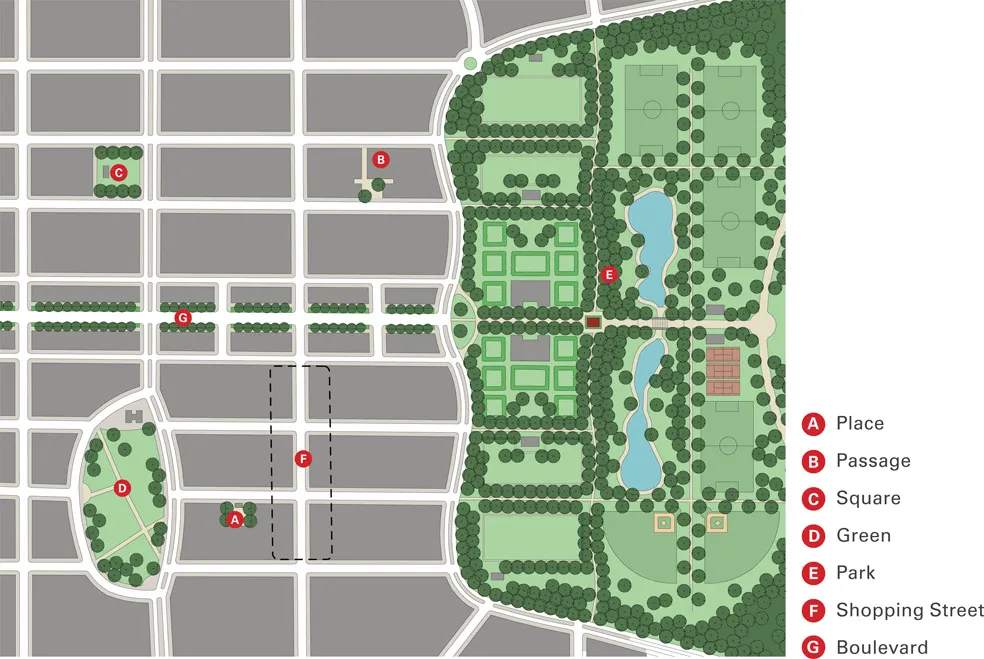![]()
Section Three
Squares, Greens, and Parks
Large, urban outdoor spaces are indispensable to the public lives of our communities. We have observed that the best spaces magnify the city’s energy and activity but also provide rest and relaxation in an urban context. Beyond this, we wanted to know what physical characteristics specifically make these great urban spaces so special. It was not difficult to formulate a list of high-quality urban spaces from around the country; their number and variety is considerable.
Our selection includes many of the most well known and historic examples of urban outdoor space, such as Boston Public Garden and Rockefeller Center; other examples, such as Santana Row and Belmar Town Center, are more recent creations that are generating considerable interest among planners, designers, and architects.
Our study combines a variety of diagrams that help us better understand the scale, layout, and workings of these spaces, including figure-ground diagrams of the site and surroundings, diagrammatic analyses of the site-plan arrangement, and sectional drawings depicting spatial enclosures. The information used to prepare these diagrams was drawn from a variety of sources, including aerial imagery, site visits, photos, and Web research.
Public Spaces: Successful Interplay of Urban Open-Space Elements
Each place type described below plays a role in creating open and public space in urban districts. Each one has a specific function and relationship to the other elements. They are listed below from smallest element to largest.
Places (or “pocket parks”) and passages are the smallest of urban spaces. They occur midblock or at contiguous corners where pedestrian movement patterns require a linkage between two major streets or activity areas.
Shopping streets must be carefully situated in order to best serve communities and complement surrounding urban spaces. Unlike squares and pocket parks, shopping streets are best located at the perimeter of a community, along home-bound routes that join up with a major boulevard. In these locations they can serve twice the catchment (communities on both sides of the boulevard will shop there), as opposed to being “buried” within a community without primary frontage. (Both places and shopping streets are studied in depth in later chapters.)
Squares are larger urban spaces and help to define an entire urban community if they are a major center of public events and activity. Squares are most successful when they combine amenities such as seating, public artwork, and a central activity space with informative signs, maps, restrooms, and security. Squares are best located at primary intersections in the center of an urban district or between two or more districts.
Greens are grassy open spaces that may be used passively or actively; they accommodate both unstructured play and programmed events. Traditionally, greens have been gathering spaces for town meetings and other large public events.
Parks are often the largest public spaces in a city and are regional destinations that accommodate a wide variety of recreational activities and major civic events. As such, their connection to an arterial street that serves the region is important to their success. Parks that share parking with surrounding commercial areas also help establish viable pedestrian movement patterns through the city.
Squares: Essential Characteristics
Squares typically serve as activity centers for urban neighborhoods with 5,000 to 25,000 inhabitants, and they vary in size from one to roughly six acres. Residents ought to be able to walk to an urban square that is within five minutes or a quarter-mile radius of their home. The classic square is edged with wide sidewalks underneath canopy shade trees or trelliswork. Well-lit, informal seating areas often ring a central event space. Small kiosks or pavilions providing food, security, or information are common in squares. A landmark, such as a public art piece or fountain, provides a place for people to meet; fountains can also mitigate traffic noise. Needless changes in level often threaten the success of urban squares because they create pedestrian barriers and should be avoided. Parking is often handled best by parallel or angled on-street parking that lines the square’s perimeter. At intersections, bulbouts reduce the distance pedestrians need to walk in order to cross the street; they als...


